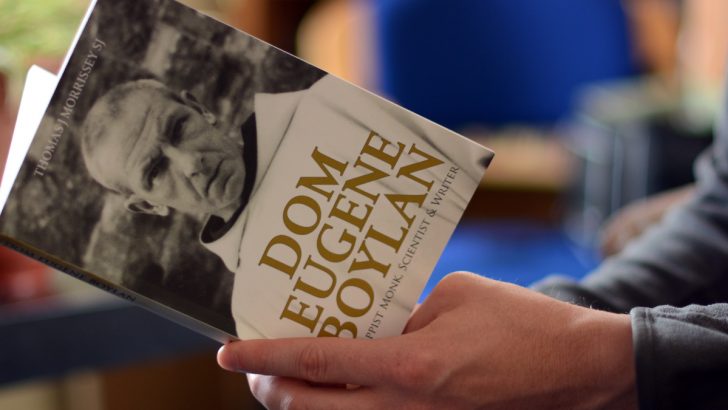Dom Eugene Boylan: Trappist Monk, Scientist & Writer
by Thomas J. Morrissey SJn (Messenger Publications, €19.95)
This is an important biography of Dom Eugene Boylan, the well-known abbot of Mount St Joseph, the Cistercian Abbey at Roscrea. He was the author of two once widely read books, This Tremendous Lover and Difficulties in Mental Prayer, which gave him an international following.
He was born on February 3, 1904 at Bray, Co. Wicklow, where his father was sub-manager in the Hibernian Bank; later his father was moved to Derry where Kevin, as he was then known, spent part of his childhood. After his primary education, Kevin was enrolled in the O’Connell Christian Brothers School in Dublin, where he excelled academically. He entered Holy Cross College, Clonliffe, the major seminary of the Archdiocese of Dublin, in 1921.
Like his classmates he attended UCD but, while they prepared to sit for an arts degree, he studied mathematics and science. The excessive supervision and repressive regulations of the seminary grated on him. Concluding that he did not have a vocation for the diocesan priesthood he left the college before Christmas of his third year.
Returning to UCD as a lay student Kevin immersed himself in the activities of the university. He joined the Literary and Historical Society, Scientific Society, Musical Society and the Swimming Club and enjoyed the social events organised by his peers.
Love of music
He secured an MSc and a travelling studentship in physics in 1925. Not least because of his love of music he opted to spend his studentship years in Vienna, city of the Strauss family and many of the other grandees of classical music. In letters home he disclosed how he enjoyed attending operas and music-enhanced High Masses on Sundays. He returned to Dublin in 1929 and took up a position as assistant lecturer in physics at UCD. His researches in cosmic physics were widely recognised.
Just two years later Kevin joined the Cistercian Order at Roscrea. After a month’s postulancy the abbot clothed Kevin with the Cistercian habit and gave him the name Eugene.
Then as a novice he shared the life of the community. This involved spending six hours of each day reciting the Divine Office as well as spending time engaged in manual work.
In due course Eugene made his final profession in 1936 and was ordained a year later. He was appointed to the staff in the Abbey school, but it seems he was not a successful teacher. However, he became popular as a confessor and preacher. As a result many requests came from religious groups for him to conduct days of spiritual conferences and to give longer retreats.
At the prompting of an Irish Christian Brother he met at one of those conferences he published Difficulties in Mental Prayer in 1943. Intended for priests and religious, it was enthusiastically received by the laity, was re-printed on numerous occasions and received universal acclaim.
In it he stressed that meditation, prayer and spiritual reading were essential to pursuing a spiritual life. Subsequently he published other books on these topics and contributed articles on cognate subjects to religious journals.
During a visit to the Abbey in Roscrea in 1952 Cardinal Gilroy invited the abbot to make a foundation in his archdiocese in Sydney. Eugene was dispatched to explore the feasibility of such a project, as the first Cistercian ever to set foot in Australia. Eventually a foundation was made at Tarrawarra, near Melbourne, and Eugene himself was given the responsibility of ensuring its financial viability.
In due course Eugene made his final profession in 1936 and was ordained a year later”
Three years later Eugene was a member of the community on Caldey Island in the Bristol Channel, near the town of Tenby in South Wales. Caldey was the site of a monastic settlement dating from early Christian times. It was acquired at the beginning of the 20th Century by a group of Anglican Benedictines who eventually were received as a community into the Catholic Church.
Subsequent to their transferring to the mainland a Cistercian monastery was established on the island. However, by the mid-1950s the community were struggling to keep it operational and the authorities sent Eugene to assist them.
After Eugene returned to Roscrea from Caldey he obtained permission to go to the US in response to appeals from American Cistercian abbots (Trappists as they were known in the US) to preach their annual retreat. While there he moved from one monastery to another.
Across the US there were 12 Cistercian foundations including the two largest monasteries in the world at Gethsemane in Kentucky and Spencer in Massachusetts. The renowned spiritual writer Thomas Merton, who was a member of the community in Gethsemane, was reported to have described Eugene’s retreat as the best he had ever attended.
Dom Camillus Claffey, abbot of Mount St Joseph Abbey, Roscrea, resigned in 1962. He was succeeded by Dom Eugene, who by then was in greater demand than ever to conduct conferences and retreats. He also became a well-known figure because of his contributions on national issues. Following a car crash Dom Eugene died in hospital on January 5, 1964.
The great Dom Eugene Boylan has never been quite forgotten, here in Ireland or in the wider world. Fr Morrissey’s very full biography will undoubtedly revive interest in not just the man, but also in his many inspiring books.



